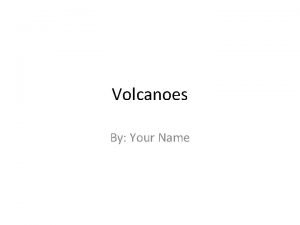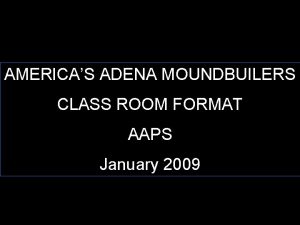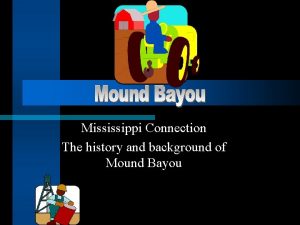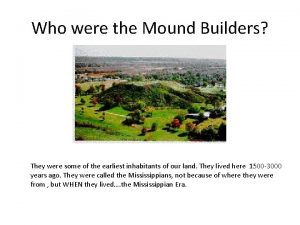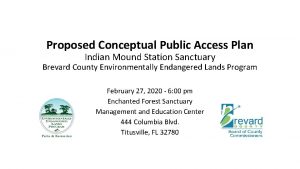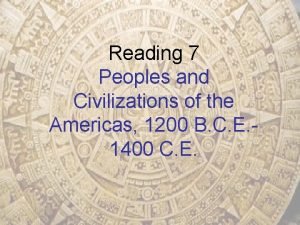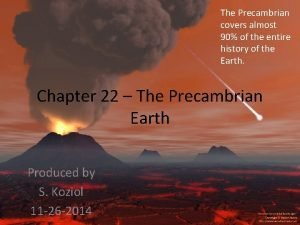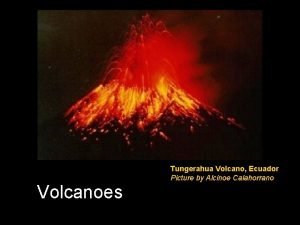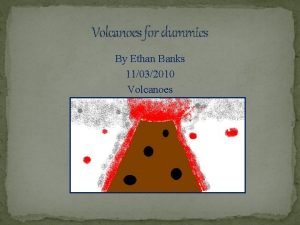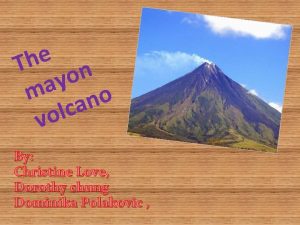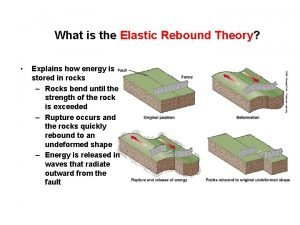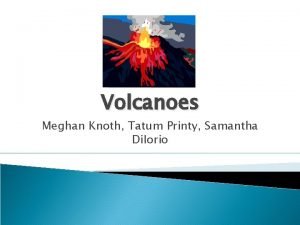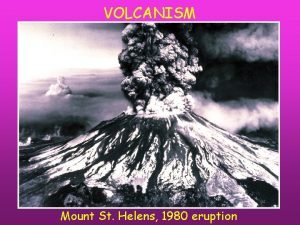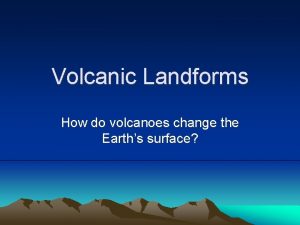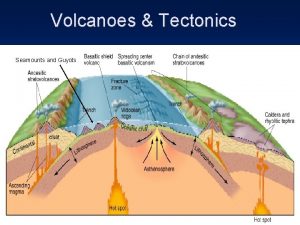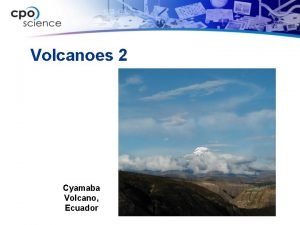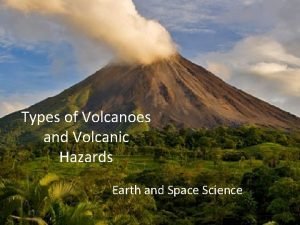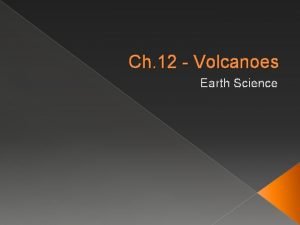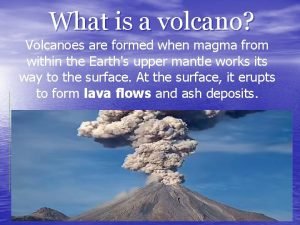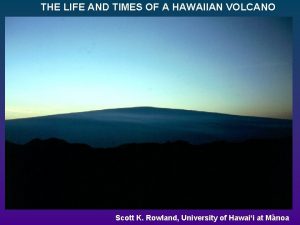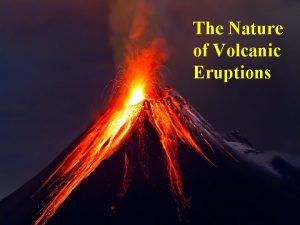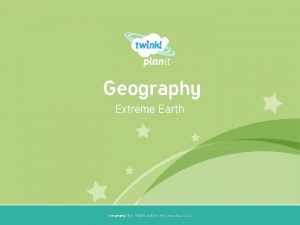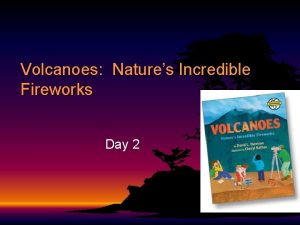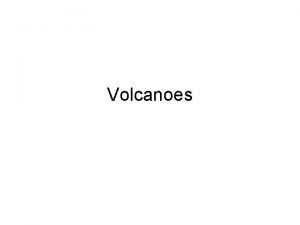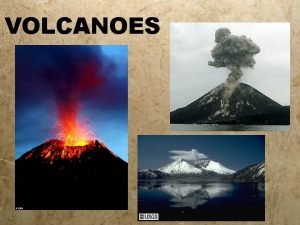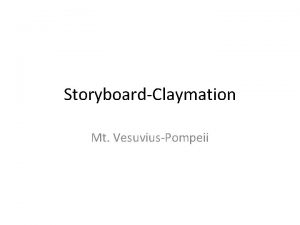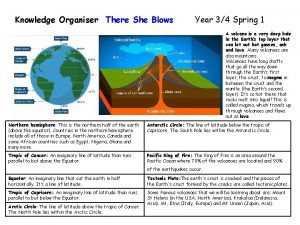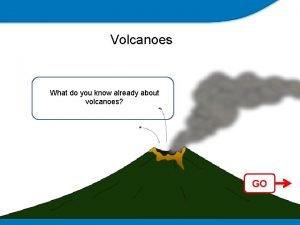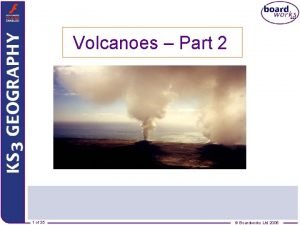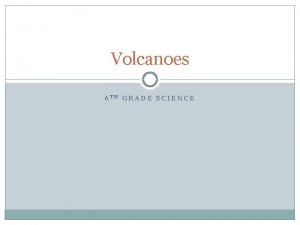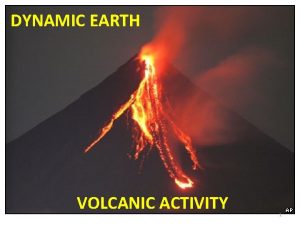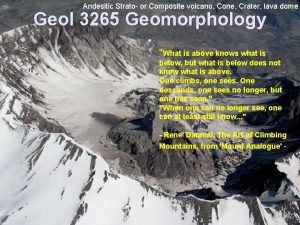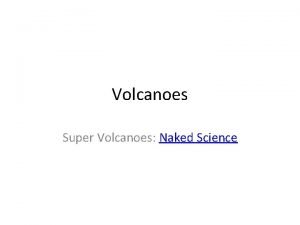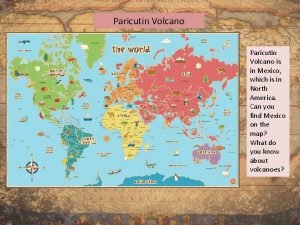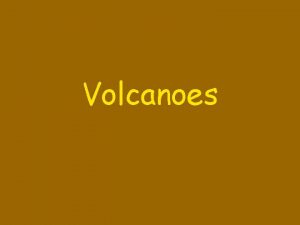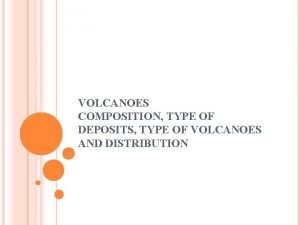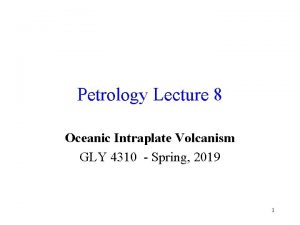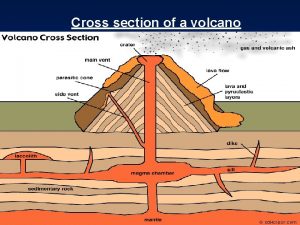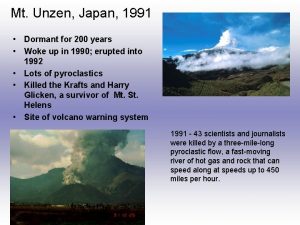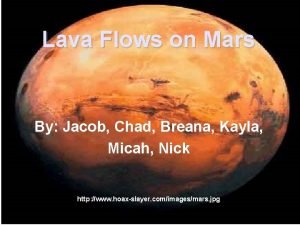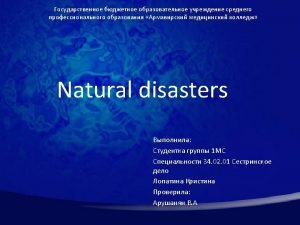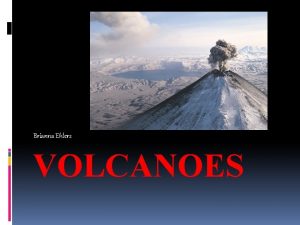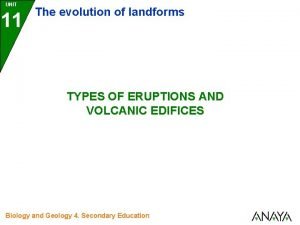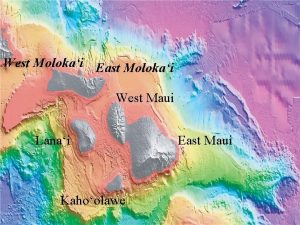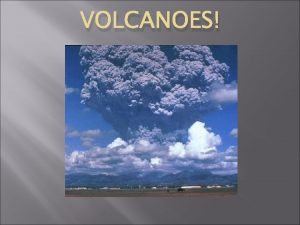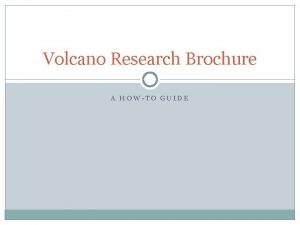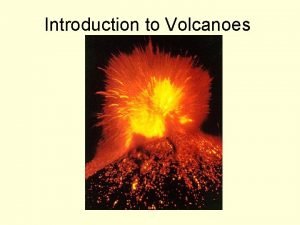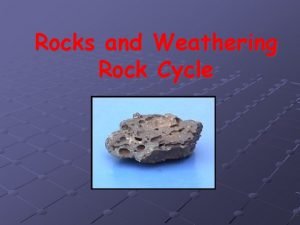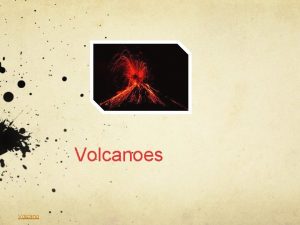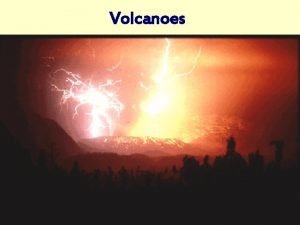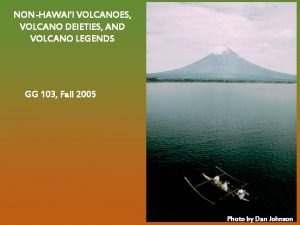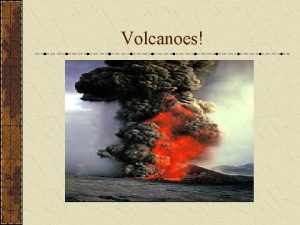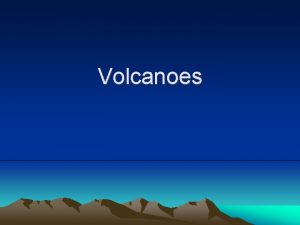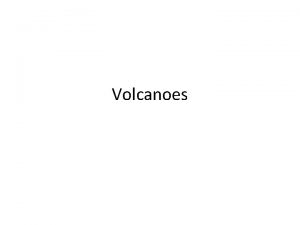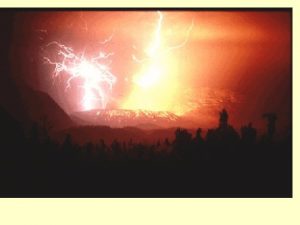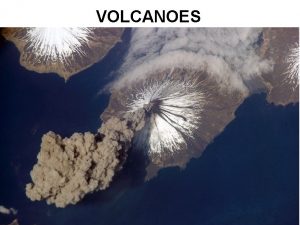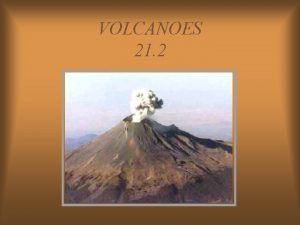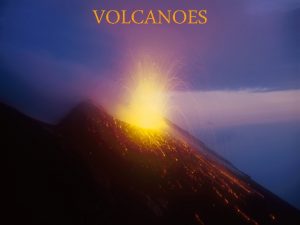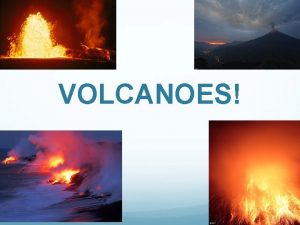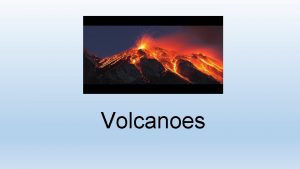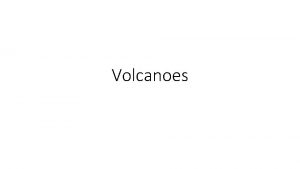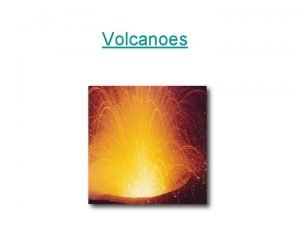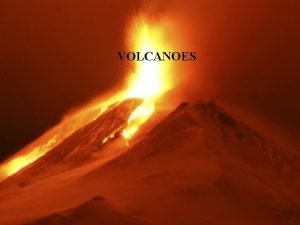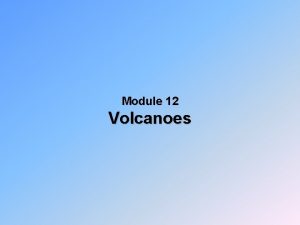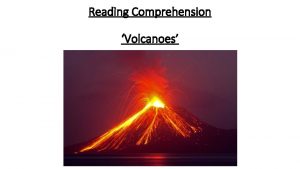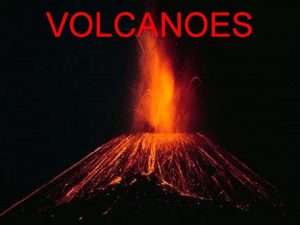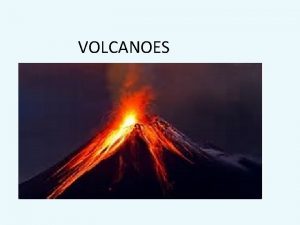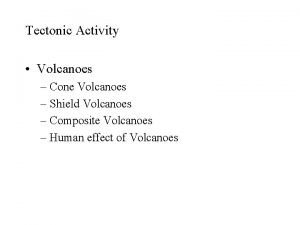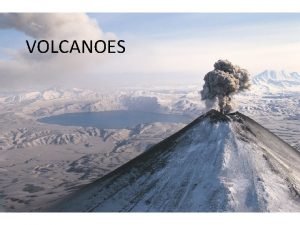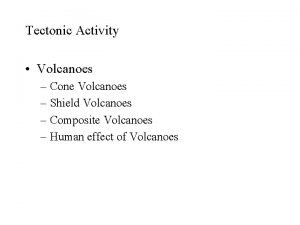VOLCANOES WHAT IS A VOLCANO Volcano A mound



























































- Slides: 59

VOLCANOES

WHAT IS A VOLCANO?

Volcano: A mound of material that is extruded to the Earth’s surface from a vent that is connected to a magma chamber via a feeder conduit.

What is a Volcano? • Magma: Molten material beneath the Earth’s surface. • Lava: Molten material above the Earth’s surface.

HOW ARE VOLCANOES CLASSIFIED?

Volcano Classification • Volcanoes are classified according to their SHAPE. • The SHAPE of a volcano depends on the Inherent Properties of the Lava that it is made up of. • These inherent properties are mainly affected by the presence or absence of 3 ingredients: – Silica (Si. O 2) – Water Vapor (H 2 O) – Carbon Dioxide (CO 2)

How The Composition of Lava Affects a Volcanoes Shape • The presence of Si. O 2, H 2 O, and CO 2 affect the shape of a volcano by changing the Viscosity of the lava. • Viscosity is a measure of how fluid the lava is. • As the composition of the lava is enriched in Si. O 2, H 2 O, and CO 2, the lava becomes thicker and more viscous. • As the viscosity increases, gases become trapped and the volcano becomes more explosive.

LAVA COMPOSITION

Lava Composition Magma Type Chemical Composition Basaltic 45 -55% Si. O 2; High in Fe, Mg, Ca; Low in K, Na. Temp. (Celsius) Viscosity Gas Content 1000 - 1200 Low Andesitic 55 -65% Si. O 2; Intermediate Fe, Mg, Ca, Na, K 800 -1000 Medium Rhyolitic 65 -75% Si. O 2; Low in Fe, Mg, Ca; High in K, Na 650 -800 High

TYPES OF VOLCANOES

3 Types of Volcanoes • Shield • Cinder Cone • Stratovolcano or Composite


Shield Volcanoes Dominated by fluid, high temperature, low viscosity basaltic magma. Low, dome-shaped profile, like an inverted shield. http: //geoimages. berkeley. edu/Geo. Images/Johnson/Landforms/Volcanism/Shield. Volcano. html


Cinder cones: dominated by pyroclastics. Forms an isolated conical mound of tephra. Photograph by J. P. Lockwood on 1 December 1975 http: //volcanoes. usgs. gov/Products/Pglossary/Cinder. Cone. html

Cinder Cones Dominated by viscous, gaseous magmas Relatively cool basaltic magmas or andesitic magmas predominate. Mount Edziza, British Columbia


Stratovolcanoes: mixture of lavas and pyroclastics. Syn. Composite volcanoes Mount Mageik volcano, Alaska Photograph by R. Mc. Gimsey on 15 July 1990 http: //volcanoes. usgs. gov/Products/Pglossary/stratovolcano. html

Stratovolcanoes Volcanoes that alternate between periods of lava flows (constructive phase) and periods of explosive eruptions (destructive phase). Commonly called “composite volcanoes” because they are made up of both lava and pyroclastic deposits. Steep slopes, at angle of repose or greater. © Noemi Emmelheinz 2001

VOLCANIC MATERIAL “Lava Flows”

Lava Flows Volcanoes also vary in terms of the types of deposits that they produce. Lava: Hot (up to 1200 degrees C), fluid, molten rock that flows along the land surface.

Lava can flow like viscous water, including forming lava falls.

Pahoehoe: Lava with a ropelike surface texture due to partial cooling as the lava flowed. Relatively hot, low viscosity lava.

Aa: Blocky, rough lava flow. Due to high viscosity lava that flowed pushing chunks of solid and semi-solid blocks.

Pillows: A form of closed lava tube (with a bulbous end) that forms when a lava flows into water (e. g. , a lake or ocean) and cools very rapidly. http: //oceanexplorer. noaa. gov/explorations/04 fire/background/volcanism/media/pillow_lava_video. html Pyroclastic material: Debris formed by a volcanic explosion. Results when magma is very viscous. Tephra: The general term for all pyroclastic material that is ejected from a volcano. Different terms apply according to the size of the tephra. (syn. Ejecta)

Lava tube: A tube formed by cooling and solidifying of the lava walls while fluid lava continued to flow inside.

VOLCANIC MATERIAL “Pyroclastics”

Nuée Ardente (glowing cloud): A hot, gaseous cloud of ash that flows down slope. Flow speeds can reach 160 km/hr and temperatures can exceed 600 degrees C. http: //volcano. und. nodak. edu/vwdocs/volc_images/img_mt_pelee. html

Tuff: A deposit made up of ash. Welded tuff: A deposit of pyroclastic material that was laid down while still very hot and particles become fused together. Ash fall: Fallout of very fine ash from the air. Volcanic ash fall during mid-day with the eruption of Mount Pinatubo in the Philippines.

Ash flow: Pyroclastic debris that flows downslope. Lahar: A water saturated slurry of ash and other volcanic debris that flows downslope.

Ash: tephra that is finer than 2 mm in diameter.

Lapilli: from 2 mm to 64 mm in diameter. Blocks: hard fragments greater than 64 mm in diameter.

Bombs: soft, partially melted fragments greater than 64 mm in diameter.

VOLCANIC ERUPTIONS

Mt. St. Helens Before Mt. St. Helens After

Extensive ash falls and ash flows are commonly produced during explosive phases.

After an eruption a large caldera remains. Crater Lake is a caldera that remains following an explosive eruption 7, 700 years ago. The eruption was 42 times more powerful than Mt. St. Helens.


WHERE ARE VOLCANOES LOCATED?

The Distribution of volcanoes

The vast majority of volcanoes are located: Parallel to oceanic trenches. Along the oceanic ridge. Over hot spots originating from the mantle.

Volcanoes along trenches Examples: Japan, most Pacific Islands, Caribbean Islands, west coast of North and South America.

2/3 of all volcanoes are along the Ring of Fire that surrounds the Pacific Ocean.

Volcanoes result from magma rising off the melting subducted plate. The composition of the magma is andesitic (melted basaltic crust plus sediment carried on the crust). Magma is very gaseous, particularly enriched with water vapor. Stratovoclanoes are constructed from feeder conduits extending to the surface.

Granitic (rhyolitic) intrusions are also formed, becoming trapped within the volcanic pile overlying the region of subduction. Potential for very explosive eruptions.

Similar situation on the west coast of North and South America. Volcanoes formed by intrusion into the mountain chains that result from compressive forces between oceanic and continental crust.


Oceanic Ridge Volcanoes Most volcanic activity is under water. Intrusion of material from the magma chamber creates new oceanic crust as the sea floor spreads. Basaltic pillow lavas dominate the submerged volcanoes.

Shield volcanoes occur where volcanic activity extends to the surface (e. g. , Iceland). Iceland is growing by volcanic expansion of the ridge.

HOT SPOTS and HAWAIIAN ISLANDS

Volcanoes and Hot Spots Hot Spot: a point on the crust immediately above a hot plume within the mantle. Heat from the mantle (and some magma) rises to the hot spot. Rising mantle material termed a mantle plume.

Hot spots can occur beneath oceanic or continental crust. Mechanism first proposed by J. Tuzo Wilson (a Canadian geophysicist) to illustrate that plates actually move.

The Hawaiian Islands consist of eastern active volcanic islands and inactive volcanic islands to the northwest.

The modern active island rests close to the hot spot and its shield volcanoes are fed from the magma that the hot spot generates. http: //www. biosbcc. net/ocean/marinesci/02 ocean/hwgeo. htm

The Pacific plate is moving towards the northwest. The volcanic islands have been successively “pushed off” the hot spot by plate movement.

As the crust moves it ages, becomes cooler and more dense, causing it to subside. The seamounts are old islands that have subsided to below sea level.

The seamounts represent even older islands that have been pushed further from the hot spot.

Recent studies suggest that the Hawaiian Hot Spot has moved over time.

THE END
 A dome mountain forms when _____.
A dome mountain forms when _____. The mound builders
The mound builders Grave creek mound tablet
Grave creek mound tablet Benjamin green mound bayou
Benjamin green mound bayou The mound builders
The mound builders Where did the mound builders live
Where did the mound builders live Indian mound station sanctuary
Indian mound station sanctuary Mound builders
Mound builders Mat or mound composed of billions of cyanobacteria
Mat or mound composed of billions of cyanobacteria Active volcanoes map
Active volcanoes map Paboeboe
Paboeboe Differentiate active and inactive volcanoes
Differentiate active and inactive volcanoes Explain the elastic rebound theory
Explain the elastic rebound theory Chapter 8 earthquakes and volcanoes
Chapter 8 earthquakes and volcanoes Lava and magma difference
Lava and magma difference Where are volcanoes
Where are volcanoes Laccolith
Laccolith Three main ways volcanoes are created
Three main ways volcanoes are created Ecuador
Ecuador What is constructive force
What is constructive force Types of volcanoes
Types of volcanoes How are volcanoes formed
How are volcanoes formed Description of volcano
Description of volcano A'a hawaiian
A'a hawaiian How do volcanoes erupt
How do volcanoes erupt How are volcanoes made
How are volcanoes made Volcanoes nature's incredible fireworks
Volcanoes nature's incredible fireworks Ring of fire volcanoes
Ring of fire volcanoes Types of volcanoes
Types of volcanoes Volcanic belts form along _____.
Volcanic belts form along _____. How are volcanoes classified?
How are volcanoes classified? Volcanoes of italy map
Volcanoes of italy map Volcanoes knowledge organiser
Volcanoes knowledge organiser What do you already know about volcanoes?
What do you already know about volcanoes? Explain the theory of plate tectonics.
Explain the theory of plate tectonics. Magma chamber
Magma chamber Name volcanoes
Name volcanoes Volcano mc-899 prometheus
Volcano mc-899 prometheus Composite volcano
Composite volcano Composite volcano def
Composite volcano def Volcano
Volcano A huge hole left by the collapsing volcanic mountain
A huge hole left by the collapsing volcanic mountain Paricutin volcano facts
Paricutin volcano facts Volcanou
Volcanou Cinder cone
Cinder cone Magma type
Magma type Oni magma volcano tamer
Oni magma volcano tamer Cross section of a cinder cone volcano
Cross section of a cinder cone volcano Lava domes
Lava domes Volcano on mars
Volcano on mars Phenomenon disaster
Phenomenon disaster Cylinder cone volcano
Cylinder cone volcano Raging planet volcano
Raging planet volcano Volcano type of eruption
Volcano type of eruption Volcano plot
Volcano plot Picture of lanai
Picture of lanai Bedrock volcano
Bedrock volcano Volcano brochure
Volcano brochure Form of volcano
Form of volcano Volcano
Volcano
